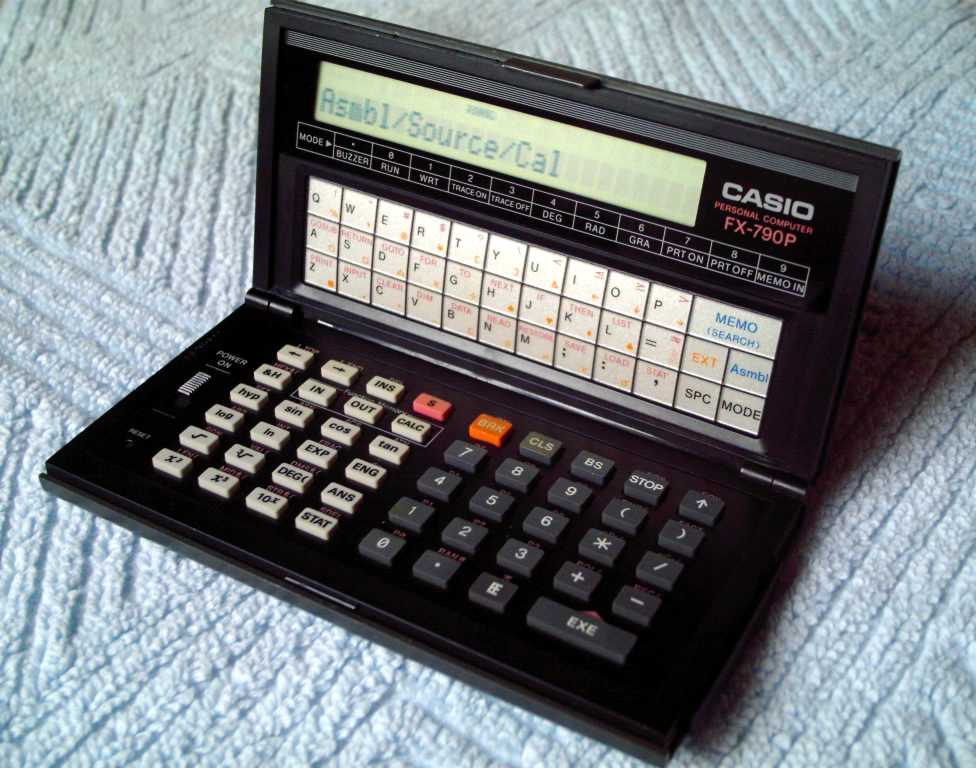 Back to GanjaTron's Site
Back to GanjaTron's Site
Casio fx-790P

[Click to enlarge]
I spotted this gadget at the International Cyprus State Fair in the summer of 1986. I was looking for something more powerful to complement my fx-6000G, and I was suitably impressed at the time. It was programmable in BASIC, which (for reasons that escape me in retrospect) I preferred to some proprietary formulaic programming model. I suppose it had something to do with my drooling over a classmate's fx-5200P at school, which had the appearance of a true scientific calculator (suggesting a formulaic programming model), but was actually programmable in BASIC.
It offers the typical functionality found in scientific calculators, but beyond that it passes as a full fledged pocket computer. With 8K of RAM (expandable to 16K with an additional RAMPack), it boasted a respectable memory size for such a device in the mid-80s.
Typical for Casio, programs are stored in slots numbered P0..P9. The BASIC programming dialect deviates slightly from the norm, but is otherwise quite comprehensive. Due to runtime interpretation, program execution is considerably slower than on formula-based programmables.
A databank function is also available for storing addresses and phone
numbers 'n' stuff. This is also accessible from BASIC for manipulation and
storage of program-generated data. A user programmable function memory
(albeit for only
As a true pocket compie, the 790P also has I/O capabilities via a 12-pin connector on the right side of the unit. This allows connection to the FP-12 thermoprinter and the FA-5 tape interface for mass storage of programs and data on audio tapes (which I found to be reasonably reliable after a bit of fiddling with the volume).
The single line, 24-character horizontal scrolling LCD is a severe constraint and precludes implementing any visually complex stuff on this gadget, although I did cram in stuff like Poker, Hangman, a Checkers-like board game, and even Star Trek... assuming you have a printer or can remember the last 8 lines! The folding case is probably not everyone's cup of tea, although mine's held out pretty well over the years. Dec. 2008 update: the latch finally gave after 20 years and snapped off. As sleek and elegant as the 790P's design is, its build quality does leave something to be desired.
So basically the 790P is a standard dinky pocket computer of its day, but with a twist: it features a built-in (simulated) assembler, a feature which, interestingly enough, disappeared from its successors. This doesn't mean you're programming the 790P directly in machine language (which would inevitably result in memory corruption and data loss), but rather a hypothetical machine.
The simulated architecture is extremely simple, featuring four general registers GR0--GR4, three special purpose registers (sequence/program counter SC, base register BR, condition code CC), and an instruction set consisting of 14 commands. Interestingly, there's no stack, but there is a JSR (jump to subroutine) instruction; the return address is stored in one of the general registers, severely limiting recursion.
The assembler source code is entered in mnemonic form (with symbolic labels) and subsequently assembled to generate the object code which can then be run. Given the sparse instruction set, the scope and capabilities of assembler programs are quite limited, consequently this feature is of little practical value, but presumably intended as a learning tool for getting into assembler programming. Still, it's an interesting doodad and quite unique in a pocket compie of that time.
I still use my 790P sporadically nowadays, though more as a calculator than for programming due to its slow speed and high battery consumption.
Hardware Issues
- High battery consumption
- Slow speed
- Foldable case design not durable; hinges and/or latch crack
Specs
| Year of introduction | 1986 |
|---|---|
| Retail price | ??? |
| Chipset | HM6264 RAM, MB64H440 gate array |
| Memory | 8Kb for programs and data, expandable to 16Kb |
| Display | Single line dot matrix LCD |
| Audio | Two tone beeper |
| I/O | 12-pin connector for FP-12 printer and FA-5 tape interface |
| Storage | Audio cassette via FA-5 tape interface |
| Programming model | Casio BASIC |
| Power Source | 2× CR2032 3V (main), 1× CR1220 3V (memory backup) |
| Rarity | Uncommon |
| Verdict | Standard BASIC pocket computer with unique built in pseudo-assembler; folding design not to everyone's taste |
Back to Retrocomputing
 Back to GanjaTron's Site
Back to GanjaTron's Site